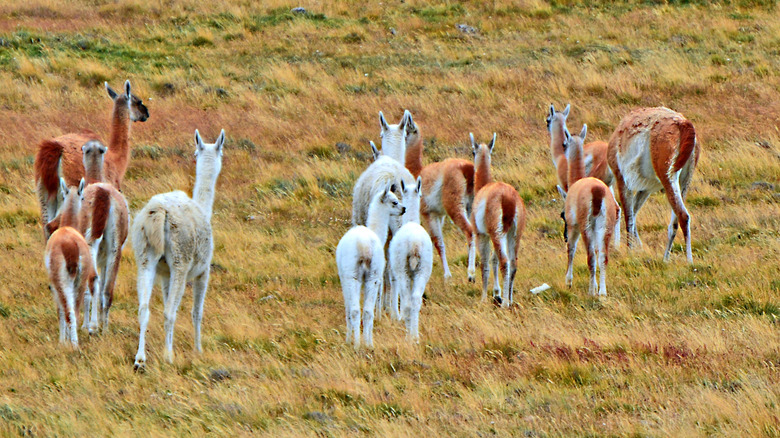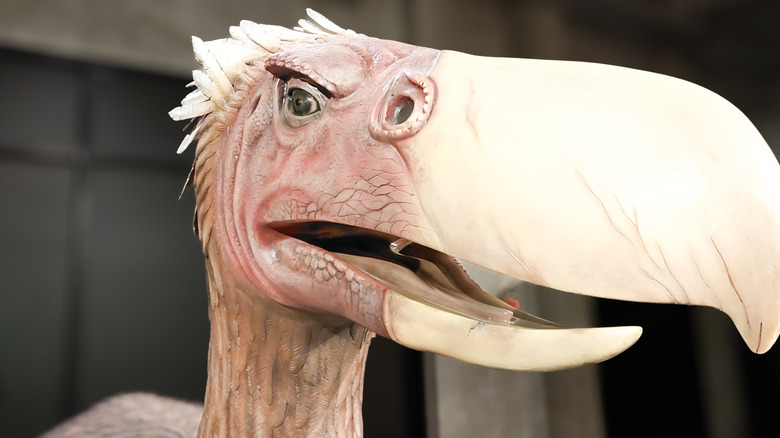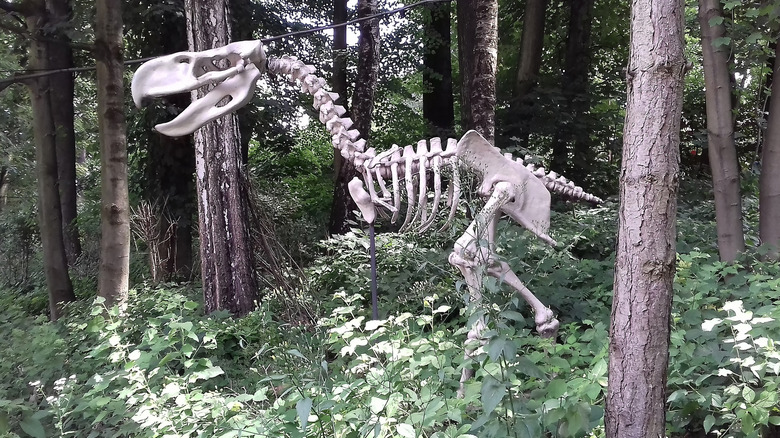What If Terror Birds Never Went Extinct?
True to their nickname, terror birds (Phorusrhacidae) are known as one of the largest and also the most fearsome birds to ever live. These were flightless birds with incredibly strong legs, which helped them run at high speeds to chase down their prey and eventually kill them with their large beaks. Also, unlike some of the birds you might be more familiar with, terror birds were as tall as 10 feet. Despite their fearsome qualities, the terror birds were eventually outnumbered by other carnivorous species of their day due to significant changes in their native South American geography and environment.
It's difficult to picture these birds taller than basketball players roaming around today. Despite the fact that the terror bird is never coming back, it's worth theorizing what modern-day life might look like if the species had never gone extinct over 2.5 million years ago. Not only would many species likely fear the terror bird, but the flightless bird would likely have struggles of its own, too.
They might prey on other birds as well as mammals
Generally speaking, there are herbivore, omnivore, and carnivore animals. When you think of birds, you might automatically refer to the more innocuous varieties, such as songbirds that might visit your backyard or local park. The majority of birds you see today are also omnivores like humans are, meaning that they eat a combination of plants and animals. For example, you might witness songbirds eating seeds as well as insects. The same cannot be said of terror birds, though.
Unlike most of the world's birds, terror birds were strictly carnivorous. In fact, they are the only known type of flightless birds that exclusively ate meat. If they existed today, they would likely eat a variety of prey, including other birds and mammals. It's possible that terror birds could prey on humans, too. This would not be the first case of birds eating humans, as research has shown some of our early ancestors being preyed upon by predatory birds.
Terror birds could compete with other carnivores for similar food sources
What likely made terror birds so frightening were their large beaks that they used to peck prey to death. Aside from their large stature overall, the terror bird is also thought to have had a head similar to that of a modern-day horse. They likely used their faces as weapons to hit their prey to death, giving them an upper hand over other carnivores. Needless to say, coming face-to-face with a terror bird would likely not go well for its victim.
As such, if terror birds never went extinct, they would likely be competing with other carnivorous species for sources of meat. This would certainly include smaller animals, such as birds and rodents, but it could theoretically also include any other animals these large birds could kill. Due to the size of these species, the terror bird would have numerous competitors, such as wildcats and bears. Some of their competitors could even include other fast-moving carnivores. While technically not the fastest bird on record, terror birds are perhaps among the fastest flightless types of birds, with running speeds estimated at above 60 miles per hour. This is similar to how fast a cheetah can run.
Terror birds and humans could meet for the first time
Humans existed when many notable species were still alive. For example, it's worth wondering what life might look like if woolly mammoths never went extinct. It turns out that the terror bird is not one of the many interesting creatures that were around when humans evolved, though. Terror birds went extinct approximately 2.5 million years ago in the regions of North and South America, and humans emerged around 2 million years ago in Africa.
While scientists believe that terror birds went extinct long before humans had a chance to encounter them, it's interesting to think about what would happen if the birds still lived in the wild in modern times. In theory, humans could meet these flightless birds for the very first time. The hypothetical reactions between these massive carnivorous birds and their human counterparts are worthy to note as well. Whether the two species could be frightened of one another, possibly hunt each other, or even peacefully co-exist alongside one another are all plausible scenarios.
Humans might hunt terror birds for food or sport
If terror birds had not gone extinct, it's possible that humans might hunt them. Whether for food or sport, humans' history of hunting is well established. In fact, humans lived alongside another large flightless bird for thousands of years, which they also hunted for food. Known as the elephant bird (Aepyornithidae), this Madagascar native is also thought to be the tallest bird to ever roam the earth. It's estimated the largest member of this bird family towered more than 10 feet tall, and weighed 1,400 pounds. From an early human hunter-gatherer's standpoint, this species would have undoubtedly provided a lot of meat.
Sadly, it was also human hunting that is thought to have contributed to the extinction of the elephant bird. While modern human societies rely less on hunting for their own food, the practice is still widespread in many parts of the world for both food and sport. Thus, if the terror bird was still around, it could possibly be prized by hunters for these reasons. It's also worth wondering how long this would last, and whether the terror bird might enjoy protective status. After all, it's estimated that humans are responsible for the most animal deaths out of any other species on Earth.
Terror birds might not be the tallest types of birds today
Terror birds are among the tallest known bird species to ever live on Earth. While considered shorter than now-extinct elephant birds from Madagascar, the terror birds were still quite formidable. There would be no mistaking this bird if you were to come across it today. Despite it being flightless, the terror bird was thought to reach heights of 10 feet tall, which is notably taller than the average human. What's more, terror birds had a lot of body mass, weighing at least an estimated 1,000 pounds.
Still, if terror birds existed today, they might not be the tallest birds alive. The modern-day ostrich, which is also a close relative of the elephant bird, is another type of flightless bird that is taller than the average human. The ostrich, when compared to a terror bird fossil, could come in at a close second place at 9 feet tall. This also makes the ostrich the tallest bird on Earth today. Unlike terror birds though, the ostrich's natural habitat is in Africa.
However, since birds are also shrinking in size over time, possibly due to climate change, it's impossible to determine which might be the tallest bird if both ostriches and terror birds were both alive today. It's possible that the terror bird might even be shorter than the ostrich. Nevertheless, if these carnivorous birds did not become extinct, they would truly stand out in a crowd if you ever came across them.
It's possible terror birds might live outside of South America
Terror birds were indigenous to modern-day Argentina, and they primarily stayed in the South American region during the species' existence. However, significant land changes forced the carnivores to evolve. First, the event known as the Great American Biotic Interchange occurred around the area of modern-day Panama caused new carnivorous mammals to make their way southward. Also known as the American Interchange of the Pliocene, this event created a land bridge between the two continents from land created after the final stages of volcanic eruptions. As a result, many animals that inhabited modern North America made their way to South America, including jaguars and llamas. This caused a new competition for food, which then led some of the terror birds to migrate to North America approximately 5 million years ago. In fact, the species made their way as far north as Florida and Texas before eventually dying off due to food competition.
It's not clear whether the lack of prey was the sole cause of extinction, or if the terror birds were already declining before this time. Nevertheless, if terror birds had survived beyond this decrease in prey, it's worth wondering whether the species might still be alive and well in the southern U.S. What's more, it's possible that the species could have migrated beyond this region to other parts of North America.
It's also possible terror birds might not adapt to the effects of climate change
Scientists believe terror birds went extinct partly due to an increase in competitors for food sources which was exacerbated by the migration of carnivorous species via the Great American Biotic Interchange. Before this time, terror birds were among the primary predators of the South American region before some of them migrated further north to look for food. This was evidenced by a subspecies uncovered in Florida. Ultimately, the birds were not able to keep up with the competition for food and did not survive these changes.
Since terror birds likely went extinct over a lack of prey from increased carnivorous competitors, it's worth wondering how modern-day strains on food could affect the species if they were alive today. Similarly, the impacts of climate change could also reduce food sources for these birds if they lived today, as there could be fewer prey. A loss of water and habitat is another factor worth considering. As research in the journal Ecological Informatics reported, it's estimated that 18% of terrestrial carnivorous mammals could become extinct over the next two decades due to habitat losses. What's more, as habitat losses increase for wild animals, humans could inevitably become prey for desperate carnivores, and terror birds could theoretically be no exception.







